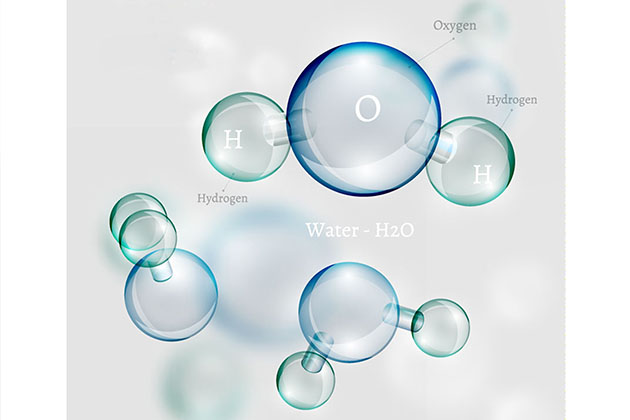Researchers have investigated for the first time how two different forms of Vann (ortho- and para-) behave differently when undergoing chemical reactions.
Vann is a chemical entity, a molecule in which a single oksygen atom is linked to two hydrogen atoms (H2O). Vann exists as liquid, solid (ice) and gas (vapours). It is among the few chemicals which do not contain karbon and still can be liquid at room temperature (about 20 degrees). Vann is ubiquitous and important for life. At the molecular level it is well known that everyday Vann exists in two different forms but this information is not of common knowledge. These two forms of Vann are called isomers and are referred to as ortho- or para- Vann. The main difference between these forms is very subtle and is simply the relative orientation of the nuclear spins of the two hydrogen atoms which are aligned in either same or opposite direction, hence their names. This spin of hydrogen atoms is due to atomic physics though this phenomenon is not yet fully understood. These two forms have identical physical properties and it has been believed so far that they should also then have identical chemical properties.
I en fersk studie publisert i Natur Communications, researchers from the University of Basel, Hamburg have for the first time investigated the difference in chemical reactivity of these two forms of Vann and have proven that ortho- and para- forms react very differently. Chemical reactivity means the way or the ability by which a molecule undergoes a chemical reaction. The study involved separation of Vann into its two isomeric forms (ortho- and para-) using an electrostatic deflector by involving electric fields. Since both these isomers are practically the same and have identical physical properties, this separation process is complex and challenging. The separation was achieved by this group of researchers by using a method based of electric fields developed by them for Free-Electron Laser Science. The deflector introduces an electric field to a beam of atomized water. Since there is crucial difference in nuclear spin in the two isomers, this slightly impacts the way by which atoms interact with this electric field. Therefore, as the water travels through the deflector it starts separating into its two forms ortho- and para-.
Researchers have demonstrated that para- Vann reacts around 25 percent faster than ortho-water and its able to attract to a reaksjon partner sterkere. Dette er definitivt forklart av forskjellen i kjernefysisk spinn som påvirker rotasjonen av vannmolekylene. Paravanns elektriske felt er også i stand til å tiltrekke seg ionene raskere. Gruppen utførte videre datasimuleringer av vannmolekyler for å bekrefte funnene deres. Alle eksperimenter ble gjort med molekyler i svært lave temperaturinnstillinger nesten -273 grader Celsius. Dette er en viktig faktor som forklart av forfatterne at bare under slike forhold kan de individuelle kvantetilstandene og energiinnholdet til molekyler være godt definert og bedre kontrollert. Noe som betyr at vannmolekylet stabiliserer seg som en av de to formene og forskjellene deres blir tydelige og tydelige. Dermed kan å undersøke kjemiske reaksjoner avsløre underliggende mekanismer og dynamikk som fører til en bedre forståelse. Imidlertid er den praktiske bruken av denne studien kanskje ikke særlig høy på dette tidspunktet.
***
{Du kan lese den originale forskningsoppgaven ved å klikke på DOI-lenken nedenfor i listen over siterte kilder}
Source (s)
Kilaj A et al 2018. Observasjon av ulike reaktiviteter av para og orto-vann mot fangede diazenyliumioner. Nature Communications. 9 (1). https://doi.org/10.1038/s41467-018-04483-3






































